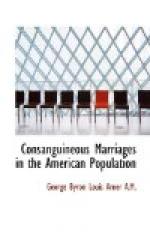[Footnote 80: From 1-1/2 to 2 per cent of all marriages were found to be between cousins within the degree of second cousins, and cousin marriages were found to be normally fertile.]
2. The Deaf. The extent to which the connection between consanguineous marriage and deaf-mutism has been studied is indicated by a table given by Mr. Huth, in which are set forth the results of fifty distinct investigations.[81] In this table the percentages of deaf-mute offspring of consanguineous marriage to the total number of deaf-mutes investigated, varies from 30 per cent to none at all. Of these studies not more than ten or eleven have the slightest statistical value, and four of these—the most reliable—are from the reports of the Census of Ireland in the years 1851, 1861, 1871 and 1881.
[Footnote 81: Marriage of Near Kin, p. 229.]
The Irish censuses of 1891 and 1901 give similar data, though not so detailed as in 1871 and 1881. Thus we have in these reports a census inquiry into a phase of the consanguineous marriage problem extending over the period of six successive censal years. Although we can hardly suppose that these figures are accurate in all respects, they throw a great deal of light upon the problem, and are worth quoting in some detail. The tables as given by Mr. Huth contain a number of errors of detail, the correction of which changes the results materially.[82]
[Footnote 82: In a subsequent article Mr. Huth corrects some of these errors. See: “Consanguineous Marriage and Deaf-mutism,” The Lancet, Feb. 10, 1900.]
TABLE XXIV. ------------------------------------------------------------
------ | | Congenital deaf-mutes | |----------------------------------------------- | | | | | Parents cousins | | | | |---------------------- | | | |Average | | |Average | | |Number |number | | |number Censal | Total | |per | to a | |Per | to a year. |population|Number|million|family[A]|Number|cent.|family[A] ------------------------------------------------------------
------ 1851[B]| 6,574,278| 4,127| 628 | —— | 242 | 5.86| 1.66 1861 | 5,798,967| 4,096| 706 | 1.22 | 362 | 8.84| 1.72 1871 | 5,412,377| 3,503| 647 | 1.30 | 287 | 7.35| 1.76 1881 | 5,174,836| 3,163| 611 | 1.32 | 191 | 6.04| 1.69 1891 | 4,706,448| 2,570| 546 | 1.40 | 297 |11.56| 1.92 1901 | 4,456,546| 2,179| 489 | 1.40 | 249 |11.43| 1.73 ------------------------------------------------------------------ [A] From Table XXV.
[B] 1851 data from Huth, “Consanguineous
Marriage and
Deaf-mutism.”
The Lancet, 1900.




